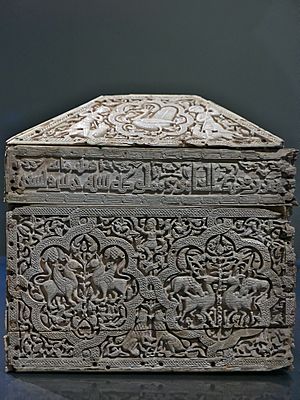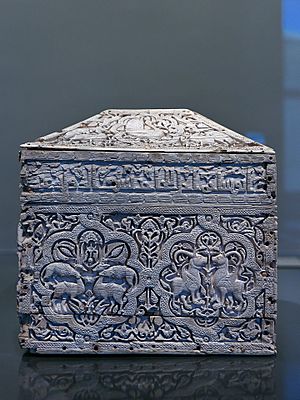Leyre Casket facts for kids
The Leyre Casket is a very special box made from elephant ivory. It's considered one of the most beautiful examples of Islamic art from Spain. This amazing casket was created in the year 1004 or 1005 in a place called the Caliphate of Cordoba. It's also sometimes known as the Leire Casket or Pamplona Casket.
Contents
What the Leyre Casket Looks Like
The Leyre Casket has a unique shape and is made from valuable materials:
- It's shaped like a rectangle, with a lid that looks like a pyramid with its top cut off.
- It's made from elephant ivory and silver.
- It's about 23.6 centimeters (about 9 inches) tall, 38.4 centimeters (about 15 inches) wide, and 23.7 centimeters (about 9 inches) deep.
This casket is famous for its incredible details and how finely it was made. It has carvings of animals like gazelles, eagles, lions, a unicorn, and antelopes in hunting scenes. There's also an old Arabic writing style called kufic script around the top. This writing names five artists who made it and the person it was given to, ʿAbd al-Malik al-Muẓaffar.
One expert, Henry Luttikhuizen, described it as a "precious container covered with elaborate ornament." He noted that it has twenty-one fancy scenes inside octagon-shaped designs. These scenes show a ruler on his throne with helpers offering him perfumes and music. There are also pictures of parties and hunts for lions and elephants. These images, along with many plant and flower designs, make the casket feel like a royal paradise.
Messages Carved on the Casket
The most important writing on the casket is an Arabic text. It's written in a decorative Kufic style with slanted letters, and it goes around the edge of the lid. This message says: "In the name of God, God be blessed, prosperity, happiness and attainment of expectations from pious works, and respite from the appointed time of death to the hājib Sayf al-Dawla, ‘Abd al-Malik, son of al-Mansūr, may God grant him success. [This is part of it] from that which was ordered to be made under the supervision of the chief page Zuhayr ibn Muhammad al-ʿAmirī, his servant in the year three hundred and ninety-five."
There are also many smaller carvings that name the artists who made the casket. These names might have been given to slaves who were skilled craftsmen:
- Inside the lid: 'ʿamal faraj maʿa talāmidhihi' (meaning 'the work of Faraj, with his apprentices')
- Right side of the lid, on a hunter's leg: 'ʿamal faraj' (meaning 'the work of Faraj')
- Front, on the throne platform: 'ʿamal misbāh' (meaning 'the work of Misbāh')
- Back, on a hunter's shield: 'ʿamal khayr' (meaning 'the work of Kayr') and 'in the name of God, God be blessed, felicity and prosperity'.
- Back, on a horse's hindquarters: '... md ʿāmir[ī]'
- Right side, on a deer's hindquarters: 'ʿamal saʿād' (meaning 'the work of Saʿād')
- Left side, on a deer's hindquarters: 'ʿamal rashīd' (meaning 'the work of Rashīd')
Journey of the Leyre Casket Through History
The Leyre Casket is the largest of 29 ivory artworks known to have been made for Muslim rulers in Spain between about 950 and 1050. It is also one of the most impressive art pieces from that time.
This casket was carved in the Caliphate of Cordoba. It was made in a royal workshop, possibly in Madinat al-Zahra (a palace-city built by Abd ar-Rahman III) or Madinat al-Zahira (another palace built by Almanzor). The year it was made is 395 in the Islamic calendar, which is 1004 or 1005 in our calendar.
The casket was created for ʿAbd al-Malik al-Muẓaffar. He was a powerful political and military leader of the caliphate from 1002 to 1008, during the rule of Hisham II. ʿAbd al-Malik was the son of Almanzor, who was also a very important leader and military commander.
Later, as Christian kingdoms fought and took over parts of Muslim Spain (a period known as the Reconquista), the casket ended up in Christian hands. It was then given to the Monastery of Leyre, which is how it got its name. It's believed that valuable items like this casket were brought north as treasures taken during these wars in the 11th century.
At the Leyre Monastery, the casket was given a new purpose. It became a reliquary, a special container to hold the bones of Saints Nunilo and Alodia. These saints were believed to have been killed for their Christian faith in the mid-9th century. Inside the casket, a piece of silk fabric was found. It had a pattern of large peacocks and likely once wrapped the saints' bones.
The casket was later kept at the Church of Santa María la Real in Sangüesa and then in the Treasury of the Cathedral of Pamplona. Today, you can see this amazing piece of history at the Navarre Museum in Pamplona.
See also
 In Spanish: Arqueta de Leyre para niños
In Spanish: Arqueta de Leyre para niños




